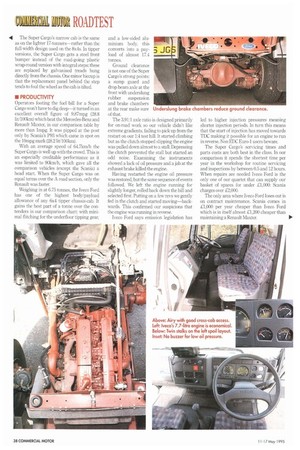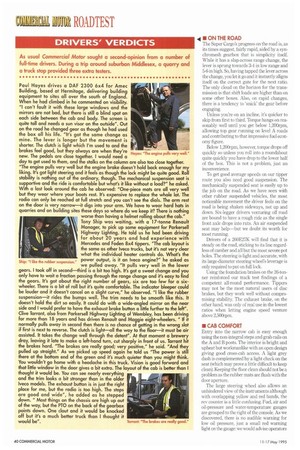sup
Page 39

Page 40

Page 42

Page 43

If you've noticed an error in this article please click here to report it so we can fix it.
Iveco Ford was previously a strong player in the six-wheeler market with its Cumminspowered old Cargo. Can its Italian-engined Super Cargo carry on the good work?
/I you want to join in with the big boy, when playing off road, you need an eightlegger. They're rough, they're tough but they cost a lot to tax and will give you just over 21 tonnes payload. Six wheelers, on the other hand are between five and ten grand cheaper to buy, save you up to .E2,800 every time you tax them and you lose "only' four tonnes in payload.
As with eight-leggers, the construction industry is the biggest user of 6x4s but they tend to be spared some of its worse excesses. With the regaining of some of the construction industry's lost confidence, the 6x4 market is looking up (so is demand for 8x4s). In 1994 6x4 registrations reached nearly 2,500: more than 1,000 up on the 1992 figure.
Iveco Ford's offering in the six-wheeler market is the British-built Super Cargo which comes with a choice of 5.9-litre (224hp) or 7 5li tr e (263hp) engines on 3.8 or 4.2m wheelbases. With rubber suspension on its 9.5-tonne drive axles the Super Cargo is classified as road friendly and can run at 26 tonnes GVW. We put an example of the longer, more powerful Super Cargo 6x4 round our tipper route to test its mettle. • PRODUCT PROFILE.
When a Super Cargo 6x4 hits the production line at Langley it gets off to a good start with high-tensile steel chassis rails which are 275mm deep by 6.7mm thick. On this is hung dual rubber suspended Rockwell SP145 chive axles. Ours was fitted with the optional 3.91:1 diff: 4.56:1 and 4.30:1 are also available. The front axle rides on steel parabolic springs with an anti-roll bar.
Power is courtesy of lveco's own 7.68-litre straight-six (non-EDC) Euro-1 engine which develops 236hp (196kW) at 2,200rpm with 7031bft (953Ntn) of torque at 1,400rpin. Our vehicle had the standard gearbox-mounted PTO but front-mounted and sandwich versions are available for cement mixers and the like.
lveco also manufactures the eight-speed synchromesh range-change gearbox with direct-drive top and a crawler. If you do get in something sticky it's nice to know that CrOSS and inter-axle diff-locks are fitted as standard. lveco Ford has resisted the urge to fit a vertical exhaust in favour of tucking it far enough up in the chassis to avoid grounding (and to get the men from the ministry on their knees). O. • The Super Cargo's narrow cab is the same as on the lighter 17-tonners----rather than the full-width design used on the 8x4s. In tipper versions, the Super Cargo gets a steel front bumper instead of the road-going plastic wrap-round version with integral steps: these are replaced by galvanised treads hung directly from the chassis. One minor hiccup is that the replacement panel behind the step tends to foul the wheel as the cab is tilted.
• PRODUCTIVITY
Operators footing the fuel bill for a Super Cargo won't have to dig deep—it turned in an excellent overall figure of 9.87mpg (28.8 lit/100km) which beat the Mercedes-Benz and Renault Maxter, in our comparison table by more than lmpg. It was pipped at the post only by Scania's P93 which came in spot on the lOmpg mark (28.2 lit/100km).
With an average speed of 64.7km/h the Super Cargo is well up with the crowd. This is an especially creditable performance as it was limited to 90km/h, which gave all the comparison vehicles (except the Scania) a head start. When the Super Cargo was on equal terms over the A road section, only the Renault was faster.
Weighing in at 6.75 tonnes, the Iveco Ford has one of the highest body/payload allowance of any 6x4 tipper chassis-cab. It gains the best part of a tonne over the contenders in our comparison chart: with minimal flitching for the underfloor tipping gear, and a low-sided aluminium body, this converts into a pay3 JG load of almost 17.4 tonnes.
Ground clearance is not one of the Super Cargo's strong points: a sump guard and drop beam axle at the front with underslung rubber suspension and brake chambers at the rear make sure of that The 3.91:1 axle ratio is designed primarily for on-road work so our vehicle didn't like extreme gradients, failing to pick up from the restart on our 1:4 test hill. It started climbing but as the clutch stopped slipping the engine was pulled down almost to a stall. Depressing the clutch prevented the stall but started an odd noise. Examining the instruments showed a lack of oil pressure and a jab at the exhaust brake killed the engine.
Having restarted the engine oil pressure was restored, but the same sequence of events followed. We left the engine running for slightly longer, rolled back down the hill and selected first. Putting on a few revs we gently fed in the clutch and started moving—backwards. This confirmed our suspicions that the engine was running in reverse.
Iveco Ford says emission legislation has led to higher injection pressures meaning shorter injection periods. In turn this means that the start of injection has moved towards TDC making it possible for an engine to run in reverse. Non EDC Euro.1 users beware.
The Super Cargo's servicing times and parts costs are both best in the class. In our comparison it spends the shortest time per year in the workshop for routine servicing and inspections by between 0.5 and 12 hours. When repairs are needed Iveco Ford is the only one of our quartet that can supply our basket of spares for under £1,000: Scania charges over £2,000.
The only area where Iveco Ford loses out is on contract maintenance. Scania comes in £1,000 per year cheaper than Iveco Ford which is in itself almost £1,200 cheaper than maintaining a Renault Maxter. • ON THE ROAD The Super Cargo's progress on the road is, as its times suggest, fairly rapid, aided by a synchromesh gearbox that is simplicity itself. While it has a slap-across range change, the lever is sprung towards 3-4 in low range and 5-6 in high. So, having tapped the lever across the change, you let it go and it instantly aligns itself on the correct gate for the next ratio. The only cloud on the horizon for the transmission is that shift loads are higher than on some other boxes. Also, on rapid changes, there is a tendency to 'snick' the gear before engaging.
Unless you're on an incline, it's quicker to skip from first to third. Torque hangs on reasonably well until you get below 1,200rpm, allowing top gear running on level A roads and contributing to that impressive fuel economy figure.
Below 1,200rpm, however, torque drops off quickly so unless you roll into a roundabout quite quickly you have drop to the lower half of the box. This is not a problem, just an inconvenience.
To get good average speeds on our tipper route you also need good suspension. The mechanically suspended seat is easily up to the job on the road. As we have seen with other rubber suspended vehicles, the most noticeable movement the driver feels on the road is being shaken sideways, not up and down. Six-legger drivers venturing off road are bound to have a rough ride as the single front axle drops into ruts. An air suspended seat may help—but we doubt its worth for most running.
Drivers of a 260E27K will find that it is steady on the road, sticking to its line regardless of camber and all but the most severe pot holes. The steering is light and accurate, with its large-diameter steering wheel's leverage is only required to put on full lock.
Using the foundation brakes on the 26-tontier reinforced our track test findings of a competent all-round performance. Tippers may not be the most natural users of disc brakes, but they work well without compromising stability. The exhaust brake, on the other hand, was only of real use in the lowest ratios when letting engine speed venture above 2,500rpm.
• CAB COMFORT Entry into the narrow cab is easy enough using the non-integral steps and grab rails on the A and B posts. The interior is bright and upbeat but workmanlike with an open design giving good cross-cab access. A light grey dash is complemented by a light check on the seat (which may prove a little difficult to keep clean). Keeping the floor clean should not be a problem as the rubber mats are flush with the door aperture.
The large steering wheel also allows an unhindered view of the instruments although with overlapping yellow and red bands, the rev counter is a little confusing. Fuel, air and oil-pressure and water-temperature gauges are grouped to the right of the console. As we discovered, there is no audible warning for low oil pressure, just a small red warning light on the gauge: we would advise operators to lit an audible warning if working on steep terrain.
Switchgear is good with the exception of the twin stalks (headlight dip and indicators) on the left of the steering column. They are too Close together and you can easily activate both stalks at once. If you need to sound the horn in a hurry it's no good using the flat of the hand on the end of the stalks -the button is on the shorter (top) one. The headlight flasher (a button on the longer, lower stalk) also takes some getting use to.
You'll have to guess which station the radio is tuned to as you haven't a chance in hell of seeing the display.
A trio of rear windows and plenty of glass to the sides and front give good all-round visibility from the driver's seat.
To match the abundance of glass the Super Cargo has plenty of ventilation with three directable vents in the centre console and another one at each end of the dash. Upper and lower ventilation is controlled independently and there's a four-speed blower if you
need some serious cooling off. To let all this air air out again Iveco's engineering department incorporated vents in the back wall of the cab. But they are positioned behind the seats and also let a noticeable amount of noise in to an otherwise very quiet cab.
Stowage space on our vehicle was reduced by the optional third seat, displacing a centre box and tray. This limited storage to a bin on the back wall of the cab and a couple of coat hooks.
• SUMMARY
Iveco Ford's Super Cargo will satisfy operators and (barring a few niggling problems with the switch gear and radio tuning) drivers too.
List price is the highest in our comparison sample, but low running costs make this an extremely competitive package. Provided you keep it off the steepest and boggiest terrain you shouldn't go far wrong with the Super Cargo.
by Colin Sowman




































































































